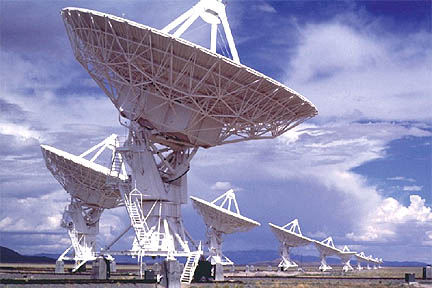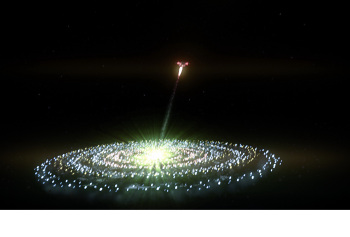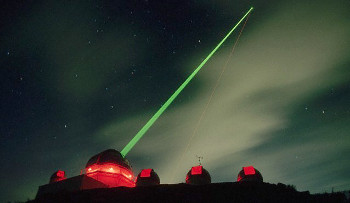Making Contact with Aliens ~ What if we Transmit the Internet into Space?

Making Contact with Aliens ~ What if we Transmit the Internet into Space?
Posted by: admin in Alien News, Aliens, Amazing, Amazing Places, Ancient Aliens, Bizarre Science, Exterrestrial Theory, First Contact, Futuristic, Space Exploration, Views from Space April 2, 2015 0 99 Views
15
SHARES
FacebookTwitterSubscribe
Making Contact with Aliens ~ What if we Transmit the Internet into Space?
Some researchers propose that we should send the entire content of our Internet into space to help aliens understand human life.
Sending the internet — with its text, pictures, videos and sounds — would allow clever extraterrestrials to decipher much about our society, and even formulate questions that could be answered with the material in hand. Sending the web on its way would take months and years if a radio transmitter were used. A powerful laser, conveying bits much like an optical fiber, could launch this data in a few days.
Sending messages — even big ones — is technically feasible. However, Is sending the entire internet content a good or bad idea?
Here is animation showing how the technology works with an explanation from the OPALS mission manager, Matt Abrahamson, plus the video NASA slated for OPALS’ first official transmission.
$bp("Brid_280591791526176585", {"id":"1736","width":"620","height":"465","video":"6420", "autoplay":0,"shared":true});
A whole debate was even held on the topic at the annual American Association for the Advancement of Science meeting last month.

NASA successfully beamed a high-definition video 260 miles from the International Space Station to Earth using a new laser communications. Will this by a means to contact aliens?
SETI pioneer Jill Tarter, the astronomer who famously served as the model for the main character in Carl Sagan’s Contact, agrees that it’s prudent to listen before we shout. “ “We should listen, first, as youngsters.” The Institute has spent five decades with their telescopes pointed to the skies, awaiting messages from life outside of Earth, but scientists involved recently expressed dissatisfaction with these passive efforts.
Douglas A. Vakoch, SETI’s director of interstellar message composition, speaks of the institute’s changing strategies to make contact with alien life.
“In the past we’ve always assumed that any extraterrestrial civilization with the capacity to detect us will automatically take the initiative to make contact, sending us a powerful signal to let us know they exist. But there may be civilizations out there that refuse to reveal their existence unless we make it clear that we want to make contact.”
He and his colleagues at SETI also assert that any extraterrestrial civilization advanced enough to detect and destroy Earth would have done so already, if those were their intentions.

SETI’s Alien Telescope Array (ATA) listens day and night for a signal from space. Credit: SETI
Seth Shostak wrote on March 27 in the opinion section of The New York Times.
We have little to lose, and possibly much to gain, by reaching out. Besides, they probably already know we’re here: Our radio and television broadcasts, and especially our military radar, have been leaking into space for some 70 years, Shostak points out.
There’s no putting the electromagnetic cat back in the bag. “Any society that’s at least 100 or 200 years more advanced than we are will be able to pick up our leakage,” says Shostak. “Unless they’ve stopped developing technology—which is of course is possible, but then they’re of no threat to us.
We could offer the aliens Big Data, says Shostak. “For example, we could transmit the contents of the Internet. Such a large corpus — with its text, pictures, videos and sounds — would allow clever extraterrestrials to decipher much about our society, and even formulate questions that could be answered with the material in hand”, he says.
“But I, for one, would hesitate to let a paranoia based on nothing more than conjecture shackle the activities of our children and our children’s children. The universe beckons, and we can do better than to declare that future generations should endlessly tremble at the sight of the stars”, concludes Shostak.
While some scientists are on board with increased efforts to contact extraterrestrials, others are skeptical and even advising caution.
Among the scientists against contacting aliens are Neil deGrasse Tyson, Stephen Hawking, Elon Musk, and Sean Carroll, some even fearing for humankind’s safety, and using the internet as a message may be a bad idea.
DeGrasse Tyson stated, “We don’t give our address to members of our own species whom we don’t know. So, the urge to give our home address to aliens? That’s audacious.” He later added, “But here’s the thing: Holding aside those uncertainties, it would be awesome to make contact with an advanced civilization.”

Any alien civilization advanced enough to detect and destroy Earth would have done so already, if those were their intentions.
Science fiction writer David Brin is an outspoken critic of Active SETI. He points to the history of our own planet, in which encounters between cultures of greatly differing technological sophistication rarely go well. “We have many examples where a technologically advanced civilization contacted a technologically less advanced civilization,” he says.
This pattern, Brin says, applies even when human beings aren’t involved. When plate tectonics brought the land masses that we now call North and South America together, about 3 million years ago, it enabled contact between the placental mammals of the north and the marsupial mammals of the south. “Within a million years, almost all of the marsupial mammals were extinct,” Brin says.
Brin doesn’t accept Shostak’s assertion that “aliens” already know we’re here (sometimes called the “barn door” issue). Shostak is too generous in calculating how visible we are from hundreds (or even thousands) of light-years away, says Brin, who holds a Ph.D. in planetary science and has done consulting work for NASA. Terrestrial radio and TV signals, from I Love Lucy to whatever is leaking out of Vandenberg and Guantánamo, are relatively weak.
Furthermore, electromagnetic signals fall off in proportion to the square of the distance (and extraterrestrials, if they exist, are pretty darn distant). Most likely, Brin says, they have no idea we’re here—and they won’t, unless we start beaming powerful, highly directed signals in the manner that Vakoch proposes.
 (The few physical-artifact messages that we’ve sent—on the Pioneer and Voyager probes, for example—are long shots in the extreme. They contain basic information about humans and our planet; on Voyager, there was also a gold record with music ranging from Mozart to Chuck Berry, and other greetings from Earthlings. They’re not heading for any particular star, and thus may never be intercepted at all—but Voyager 1 will be within two light-years of a star called Gliese 445 in about 40,000 years.)
(The few physical-artifact messages that we’ve sent—on the Pioneer and Voyager probes, for example—are long shots in the extreme. They contain basic information about humans and our planet; on Voyager, there was also a gold record with music ranging from Mozart to Chuck Berry, and other greetings from Earthlings. They’re not heading for any particular star, and thus may never be intercepted at all—but Voyager 1 will be within two light-years of a star called Gliese 445 in about 40,000 years.)
A better approach is to note that the nearest intelligent extraterrestrials are likely to be at least dozens of light-years away. Even assuming that active SETI provokes a reply, it won’t be breezy conversation. Simple back-and-forth exchanges would take decades. This suggests that we should abandon the “greeting card” format of previous signaling schemes, and offer the aliens Big Data via the internet.
Should the entire content of our Internet be sent into Space?
 Any alien civilization capable of decrypting our internet content would have everything they need in order to make contact, annihilate our species, or both. It could be bad if they took one glance at the number of puppy videos, porn sites, and other perpetual nonsense circulating the wires and decide we’re not ready for contact….or we need to be eliminated.
Any alien civilization capable of decrypting our internet content would have everything they need in order to make contact, annihilate our species, or both. It could be bad if they took one glance at the number of puppy videos, porn sites, and other perpetual nonsense circulating the wires and decide we’re not ready for contact….or we need to be eliminated.
Brent Peterson
UAATN
Source ufoandalientruthnetwork.com
Thanks to: http://alien-ufo-sightings.com

Making Contact with Aliens ~ What if we Transmit the Internet into Space?
Posted by: admin in Alien News, Aliens, Amazing, Amazing Places, Ancient Aliens, Bizarre Science, Exterrestrial Theory, First Contact, Futuristic, Space Exploration, Views from Space April 2, 2015 0 99 Views
15
SHARES
FacebookTwitterSubscribe
Making Contact with Aliens ~ What if we Transmit the Internet into Space?
Some researchers propose that we should send the entire content of our Internet into space to help aliens understand human life.
Sending the internet — with its text, pictures, videos and sounds — would allow clever extraterrestrials to decipher much about our society, and even formulate questions that could be answered with the material in hand. Sending the web on its way would take months and years if a radio transmitter were used. A powerful laser, conveying bits much like an optical fiber, could launch this data in a few days.
Sending messages — even big ones — is technically feasible. However, Is sending the entire internet content a good or bad idea?
Here is animation showing how the technology works with an explanation from the OPALS mission manager, Matt Abrahamson, plus the video NASA slated for OPALS’ first official transmission.
Initialize ads
A whole debate was even held on the topic at the annual American Association for the Advancement of Science meeting last month.

NASA successfully beamed a high-definition video 260 miles from the International Space Station to Earth using a new laser communications. Will this by a means to contact aliens?
SETI pioneer Jill Tarter, the astronomer who famously served as the model for the main character in Carl Sagan’s Contact, agrees that it’s prudent to listen before we shout. “ “We should listen, first, as youngsters.” The Institute has spent five decades with their telescopes pointed to the skies, awaiting messages from life outside of Earth, but scientists involved recently expressed dissatisfaction with these passive efforts.
Douglas A. Vakoch, SETI’s director of interstellar message composition, speaks of the institute’s changing strategies to make contact with alien life.
“In the past we’ve always assumed that any extraterrestrial civilization with the capacity to detect us will automatically take the initiative to make contact, sending us a powerful signal to let us know they exist. But there may be civilizations out there that refuse to reveal their existence unless we make it clear that we want to make contact.”
He and his colleagues at SETI also assert that any extraterrestrial civilization advanced enough to detect and destroy Earth would have done so already, if those were their intentions.

SETI’s Alien Telescope Array (ATA) listens day and night for a signal from space. Credit: SETI
Seth Shostak wrote on March 27 in the opinion section of The New York Times.
We have little to lose, and possibly much to gain, by reaching out. Besides, they probably already know we’re here: Our radio and television broadcasts, and especially our military radar, have been leaking into space for some 70 years, Shostak points out.
There’s no putting the electromagnetic cat back in the bag. “Any society that’s at least 100 or 200 years more advanced than we are will be able to pick up our leakage,” says Shostak. “Unless they’ve stopped developing technology—which is of course is possible, but then they’re of no threat to us.
We could offer the aliens Big Data, says Shostak. “For example, we could transmit the contents of the Internet. Such a large corpus — with its text, pictures, videos and sounds — would allow clever extraterrestrials to decipher much about our society, and even formulate questions that could be answered with the material in hand”, he says.
“But I, for one, would hesitate to let a paranoia based on nothing more than conjecture shackle the activities of our children and our children’s children. The universe beckons, and we can do better than to declare that future generations should endlessly tremble at the sight of the stars”, concludes Shostak.
While some scientists are on board with increased efforts to contact extraterrestrials, others are skeptical and even advising caution.
Among the scientists against contacting aliens are Neil deGrasse Tyson, Stephen Hawking, Elon Musk, and Sean Carroll, some even fearing for humankind’s safety, and using the internet as a message may be a bad idea.
DeGrasse Tyson stated, “We don’t give our address to members of our own species whom we don’t know. So, the urge to give our home address to aliens? That’s audacious.” He later added, “But here’s the thing: Holding aside those uncertainties, it would be awesome to make contact with an advanced civilization.”

Any alien civilization advanced enough to detect and destroy Earth would have done so already, if those were their intentions.
Science fiction writer David Brin is an outspoken critic of Active SETI. He points to the history of our own planet, in which encounters between cultures of greatly differing technological sophistication rarely go well. “We have many examples where a technologically advanced civilization contacted a technologically less advanced civilization,” he says.
This pattern, Brin says, applies even when human beings aren’t involved. When plate tectonics brought the land masses that we now call North and South America together, about 3 million years ago, it enabled contact between the placental mammals of the north and the marsupial mammals of the south. “Within a million years, almost all of the marsupial mammals were extinct,” Brin says.
Brin doesn’t accept Shostak’s assertion that “aliens” already know we’re here (sometimes called the “barn door” issue). Shostak is too generous in calculating how visible we are from hundreds (or even thousands) of light-years away, says Brin, who holds a Ph.D. in planetary science and has done consulting work for NASA. Terrestrial radio and TV signals, from I Love Lucy to whatever is leaking out of Vandenberg and Guantánamo, are relatively weak.
Furthermore, electromagnetic signals fall off in proportion to the square of the distance (and extraterrestrials, if they exist, are pretty darn distant). Most likely, Brin says, they have no idea we’re here—and they won’t, unless we start beaming powerful, highly directed signals in the manner that Vakoch proposes.
 (The few physical-artifact messages that we’ve sent—on the Pioneer and Voyager probes, for example—are long shots in the extreme. They contain basic information about humans and our planet; on Voyager, there was also a gold record with music ranging from Mozart to Chuck Berry, and other greetings from Earthlings. They’re not heading for any particular star, and thus may never be intercepted at all—but Voyager 1 will be within two light-years of a star called Gliese 445 in about 40,000 years.)
(The few physical-artifact messages that we’ve sent—on the Pioneer and Voyager probes, for example—are long shots in the extreme. They contain basic information about humans and our planet; on Voyager, there was also a gold record with music ranging from Mozart to Chuck Berry, and other greetings from Earthlings. They’re not heading for any particular star, and thus may never be intercepted at all—but Voyager 1 will be within two light-years of a star called Gliese 445 in about 40,000 years.)A better approach is to note that the nearest intelligent extraterrestrials are likely to be at least dozens of light-years away. Even assuming that active SETI provokes a reply, it won’t be breezy conversation. Simple back-and-forth exchanges would take decades. This suggests that we should abandon the “greeting card” format of previous signaling schemes, and offer the aliens Big Data via the internet.
Should the entire content of our Internet be sent into Space?
 Any alien civilization capable of decrypting our internet content would have everything they need in order to make contact, annihilate our species, or both. It could be bad if they took one glance at the number of puppy videos, porn sites, and other perpetual nonsense circulating the wires and decide we’re not ready for contact….or we need to be eliminated.
Any alien civilization capable of decrypting our internet content would have everything they need in order to make contact, annihilate our species, or both. It could be bad if they took one glance at the number of puppy videos, porn sites, and other perpetual nonsense circulating the wires and decide we’re not ready for contact….or we need to be eliminated.Brent Peterson
UAATN
Source ufoandalientruthnetwork.com
Thanks to: http://alien-ufo-sightings.com






 Sat Mar 23, 2024 11:33 pm by globalturbo
Sat Mar 23, 2024 11:33 pm by globalturbo

